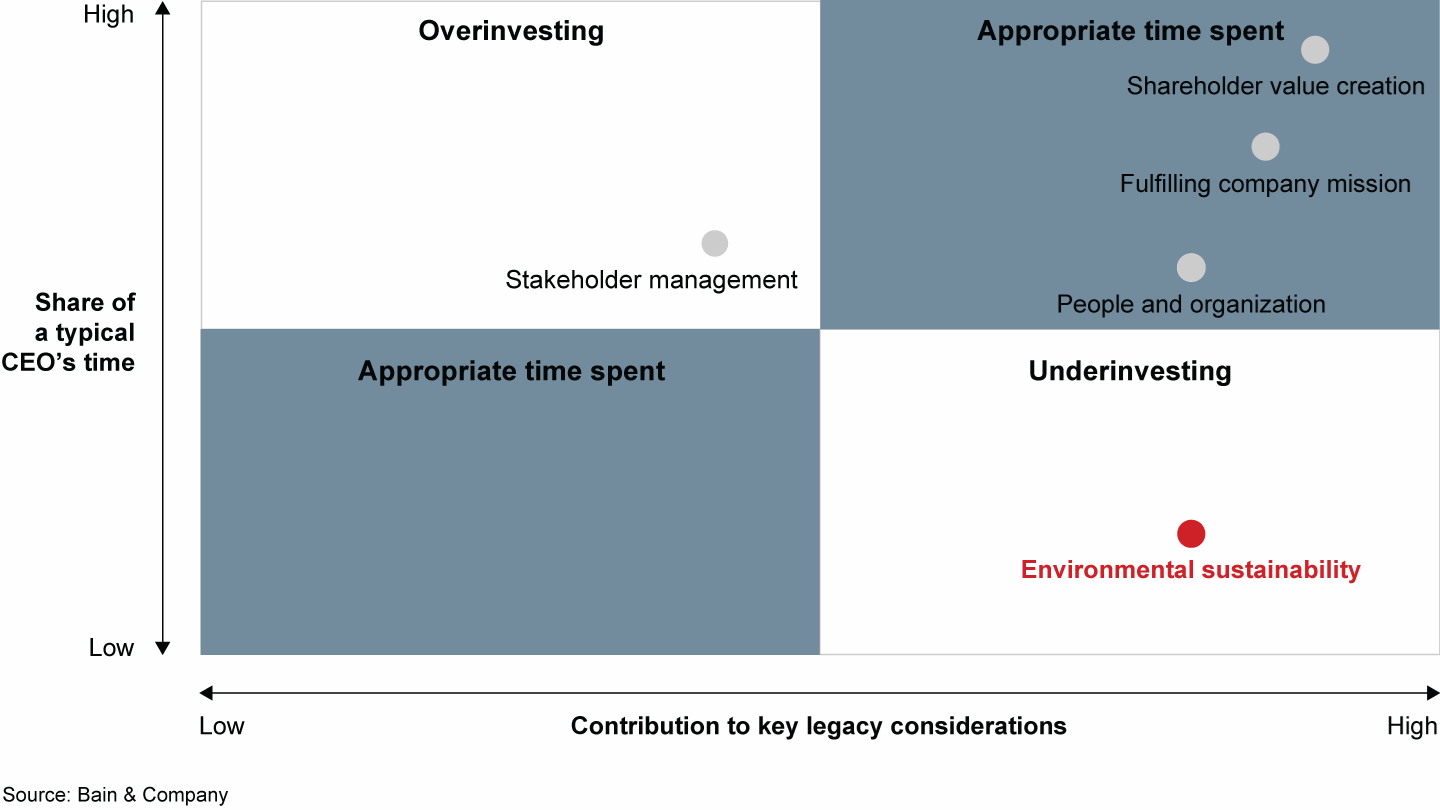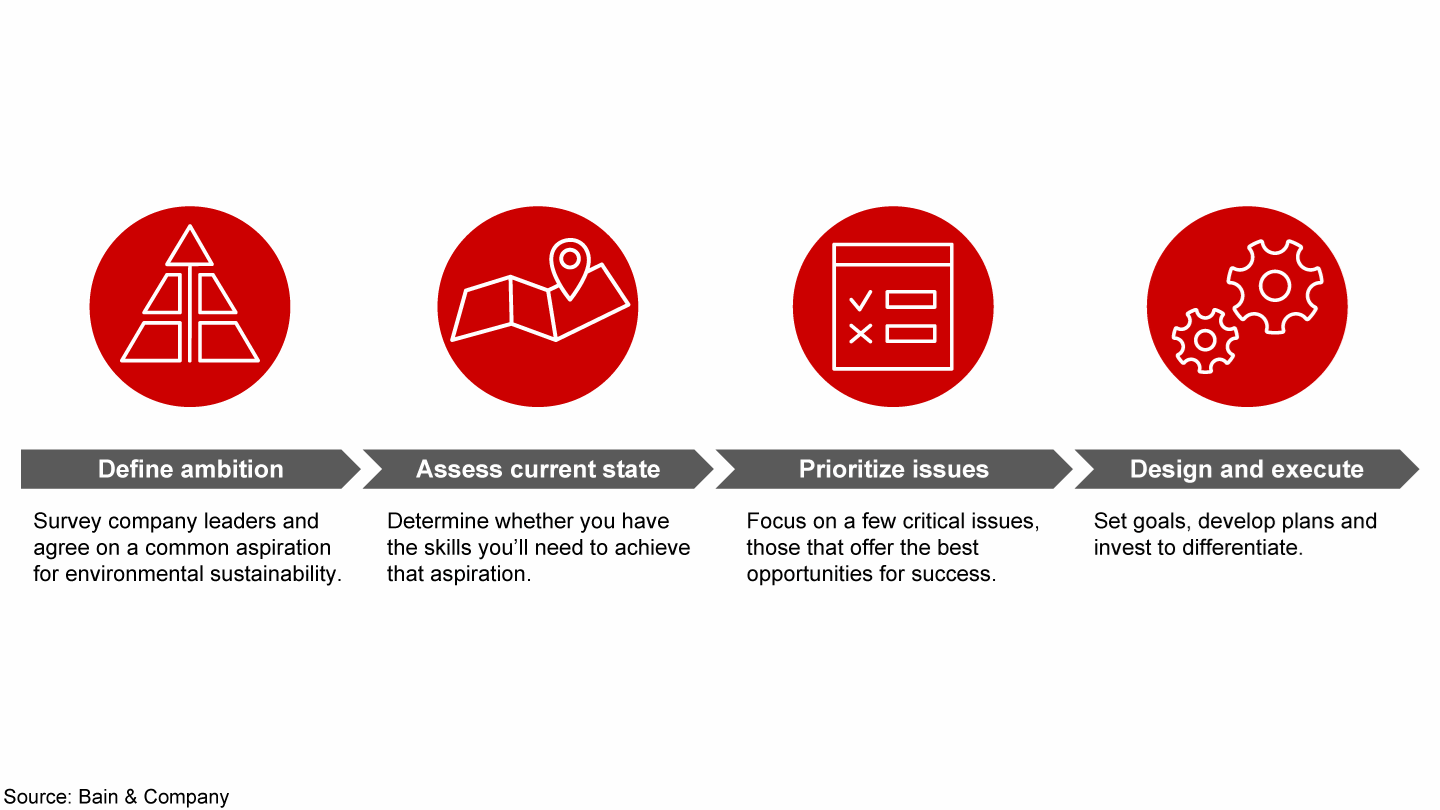Brief

Executive Summary
- Most CEOs say that environmental sustainability is important, but few give it as much time as they do to other priorities.
- One reason is that they don’t have access to current, comprehensive data on their environmental sustainability efforts, which hinders good decision making.
- Many also struggle to measure returns on investments in environmental sustainability, since some efforts take years to pay off and are beyond the four walls of the organization.
- A structured approach that includes a rigorous assessment, a plan for action, and greater accountability for executives can help break the inertia and raise sustainability to the prominence it deserves.
Ask CEOs in energy and natural resources industries what’s most important to them and their legacy, and the issues of environmental stewardship and sustainability often rank high on the list. For many senior executives, this touches at the core of their contribution: What will be the societal legacy of their tenure as CEO? Have they used their influence to leave the world in a better place than they found it? Will their children be proud of the impact they’ve had?
However, if you look at where CEOs spend their time, environmental sustainability ranks low—much lower than you might expect, given the importance leaders place on it (see Figure 1). Too often, CEOs find themselves in a reactive mode, addressing environmental issues only when an issue threatens to create public relations problems or limit business performance.
Most CEOs rank environmental sustainability as an important issue, but devote relatively little time to it


In addition to its prominence as a key legacy issue for CEOs, environmental sustainability has become a critical business issue. Consumers and customers are demanding greater accountability from corporations, top young talent is increasingly attracted to companies with a proactive environmental agenda and investors are beginning to favor companies that are leading in this arena.
Despite this, few important issues on a CEO’s agenda are managed as reactively as environmental sustainability. Often the majority of CEO time dedicated to the topic is spent responding to regulatory or nongovernmental organization (NGO) pressures, or managing near-term risks or crises. Given the importance CEOs place on the topic, why do so many manage environmental sustainability this way?
There are several reasons why this critical issue fails to get the place it deserves on the CEO’s agenda.
- Bundled with a broad set of corporate responsibility issues. As environmental sustainability becomes an existential issue in some sectors, as well as an emerging opportunity for new business, CEOs must ensure that it doesn’t get lost in the mix of corporate social responsibility (CSR) programs. Environmental sustainability is increasingly likely to demand more time and resources from the organization than other CSR topics like philanthropy or governmental relations. Today, however, CEOs might receive a quarterly scorecard from an executive charged with all of these issues, rather than getting continuous and executable information on this one—which seems out of sync with the elevated prominence the topic requires in many corporations.
- Unclear how to make decisions. CEOs can’t act on environmental sustainability issues if they don’t have the data they need to make smart decisions. When we ask CEOs to identify the five most pressing environmental issues across their supply chain, most can’t answer the question. They certainly know where they’re at risk of not getting a permit based on environmental restrictions, and they probably know where NGOs, shareholders and customers are pressuring them to act on certain issues. But these are reactive stances. Most CEOs aren’t taking a proactive, holistic approach to environmental sustainability the way they would with other business decisions.
- Difficult to measure returns. Traditional metrics do a poor job of indicating the return on investment for environmental sustainability. While some actions offer traditional returns, much of the holistic return lies in avoiding future problems, strengthening a future competitive advantage, or improving the profile of the company for employees and investors.
Given these barriers, it should come as no surprise that nearly half of all environmental sustainability programs are considered failures by the companies deploying them—and the failure rate is increasing over time as programs become more ambitious.
Take action
Bain’s environmental sustainability work with senior executives demonstrates that they don’t have to settle for a reactive mode. Companies can better measure and manage their environmental footprint by applying some of the same rigorous analysis and processes they apply to other issues critical to their business.
In some ways, a sustainability transformation is like a cost transformation, requiring a defined ambition, a data-driven assessment of the current state, identification of opportunities and priorities, and a well-executed change program (see Figure 2). Taking these steps can help CEOs break the inertia that hampers so many environmental sustainability programs, and implement lasting change.
A structured plan helps executives identify and pursue their best environmental opportunities


Several specific steps can help CEOs get started on managing this elusive task.
- Ensure environmental sustainability receives its own focus. Environmental sustainability joined the corporate agenda as one of a handful of social issues, but for many, it has become more urgent, even existential in some sectors. Identifying it as such forces executives to develop a consensus on what the organization wants to achieve. Do you want to be at the forefront of environmental sustainability, or are you aiming to reduce your impact by some measurable amount? How can you retain your social license to operate over the next decade and beyond? How will your actions position you against competitors?
- Put a data-driven business leader in charge. Treat environmental sustainability like any other critical issue by assigning it to a leader with a proven track record. This executive should be someone who can make data-based decisions on sustainability in the same way they would make a decision about an investment in a hard asset or acquisition. Among their first tasks: assessing the company’s capabilities to measure and act on environmental issues. This will uncover lost opportunities and identify capabilities that need to be developed.
- Find the data you need to make smart decisions. Most companies well understand the sustainability issues that receive consistent external scrutiny or that pose an existential threat to their companies. Fewer are aware of how much they can impact their environmental footprint in broader ways, particularly beyond the four walls of their organization. Looking upstream to suppliers and downstream to customers enables companies to develop a holistic heat map of opportunities, and will identify where partnerships are necessary to bring about those changes. One leading natural resources player that was addressing the sustainability of its processing plants was surprised to discover it could achieve greater, faster impact by focusing on targeted improvements in its supply chain. Another discovered a win-win opportunity to help its customers reduce their own carbon profile by using their products more efficiently. By reprioritizing focus, these companies improved their environmental impact more rapidly and cost-effectively than they could have by focusing only on reactive or internal items.
Nurture persistence
Communicating a commitment to environmental sustainability is easy and sure to earn praise for any CEO that asserts good intentions. Maintaining focus over time is much harder. Rarely is the topic of greening your business the most urgent issue of the day. Waiting for that day will leave CEOs in a reactive stance.
As much as any important transformational topic, environmental sustainability requires some structure to make it happen and some forcing functions to keep it moving. Setting up a regular cadence of meetings with the head of environmental sustainability and other senior executives is one way to force prominence and follow-through on the issues. Incorporating the right metrics in a visible business performance dashboard is another.
Finally, in most companies, the CEO alone has the ability to elevate environmental sustainability as a critical business priority within the company. After all, it’s the CEO whose legacy will be defined in part by the actions taken during their watch. Chief executives who are serious about making an impact must lead from the top, give the issue the time and attention it deserves, and drive the organizational commitment needed to break through business as usual. Successful CEOs don’t wait for external forces to dictate their agenda on other critical business issues. Why should sustainability be any different?
Dalton Maine and Sasha Duchnowski are partners and Andrew Keech is a principal in Bain & Company’s Global Energy & Natural Resources practice. All three are based in Chicago.